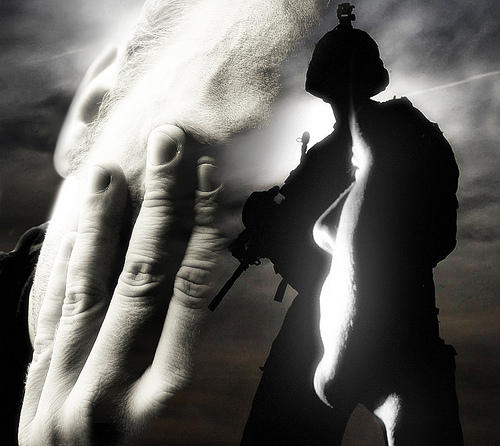Afghanistan veteran Yan Berube was handling a gun and planning to kill himself when he was arrested at this home in 2010. The incident was attributed to his diagnosed case of Post-Traumatic Stress Disorder (PTSD).
In 2008, Cpl. Stuart Langbridge, also a veteran of Afghanistan, hanged himself at Canadian Forces Base Edmonton. His family said he had PTSD. On September 10, Greg Matters was shot dead during a confrontation with RCMP officers. Matters had served with the Canadian Forces in Bosnia and had recently sought treatment for PTSD.
These incidents were not isolated. They were not flukes and they were not coincidences. They were the result of PTSD, an anxiety disorder brought on by psychologically traumatizing situations, such as military combat. Berube, Langbridge and Matters were not the first Canadian veterans whom PTSD led to a tragic end. And, barring some miracle, they will not be the last.
PTSD has an ugly way of taking over the lives of those afflicted with it, and their families’ lives too. “Drug and alcohol addiction, family abuse, domestic abuse, dissolution of the family, the vet ending up on the streets. It’s just a terrible road,” said Mike Blais.
Blais is the President and Founder of Canadian Veterans Advocacy (CVA), a non-profit organization that works to improve Canadian veterans’ quality of life. One of the CVA’s major goals is to see a comprehensive, family-inclusive PTSD treatment program established for Canadian veterans. Ideally that would include assigning PTSD patients to a team of local mental health professionals that would provide them with a full range of support.
Such a treatment program is but a far-flung dream compared to the military’s existing one. There are currently 378 mental health care professionals employed by the Canadian Forces. But they are spread thin, especially in the country’s more remote areas. In a recent report, Canadian Military Ombudsman Pierre Daigle observed that the military’s mental health treatment system is 15 to 22 per cent understaffed in some places.
With Canada’s combat role in Afghanistan winding down, the need for a more responsible PTSD treatment program is becoming urgent. According to a 2011 Parliamentary Report on PTSD and Mental Health in the Canadian Forces, between 25,000 and 35,000 soldiers are expected to be discharged over the next five years. Based on past rates of diagnosis, as many as 2,750 of them will suffer from a severe form of PTSD.
The military has already determined that eight per cent of personnel who served in Afghanistan between 2001 and 2008 suffer from PTSD. And there are thousands more veterans who are, or will be, seeking professional help for other combat-related mental illnesses, such as depression and general anxiety.
Taken as a whole, the numbers suggest a frightening workload for an overmatched, underequipped, understaffed mental health treatment program that is already straining to offer basic psychological services.
The shortfall in treatment capacity has had a demonstrable impact on individual soldiers and their families. CFB Petawawa is home to 5,400 military personnel. Most of them are members of the 2 Canadian Mechanized Brigade Group, which has been rotating in and out of service in Afghanistan since 2003. Dozens of cases of PTSD have been diagnosed at Petawawa and yet there is no on-base psychologist and only one on-base psychiatrist. That psychiatrist works just a half-day per week and many of the base’s PTSD sufferers have to travel to Ottawa to seek treatment.
In May, a PTSD-afflicted Afghanistan veteran was kidnapped from Petawawa by his own father, who took him to get private treatment. The soldier had recently attempted suicide for the second time and had been relapsing into alcoholism and depression while the base’s medical personnel allegedly left him unsupervised.
In what may have been a pre-emptive response to the Ombudsman’s report last month, Minster of National Defence Peter MacKay pledged $11.4 million to hire 51 new on-base psychological care professionals. Though a good first step, that $11.4 million will have to stretch a long way to fill the chasm-like gaps in treatment on remote bases such as Petawawa.
And whether the government pledges $11.4 million or $11.4 trillion is moot unless attitudes toward PTSD change amongst the soldiers themselves.
Blais believes that the biggest roadblock to proper treatment of PTSD is the stigma that the condition still carries. Military culture is one that emphasizes physical and mental toughness, and mental illness just doesn’t jibe with that ideal. “Most of these guys are very proud,” Blais said. “They’ve come through many years, if not decades, of ‘Suck it up, buttercup, and move on.'”
Many soldiers suffering from PTSD keep quiet about their symptoms so as not to be labeled “weak” or “crazy” by their buddies. At Petawawa the vehicle that takes soldiers to PTSD treatment is known to the rank and file as the Bus of Shame. “Who the hell wants to get on the Bus of Shame?” said Blais. “That term says it all about the mentality that exists [around PTSD].”
Like most mental illnesses, PTSD can be effectively controlled through proper psychological treatment and counselling. That’s the bright spot at the end of this long, dark road. But for Canadian Forces veterans to get there, someone has to ensure they step forward and that, once they do, they are given the help they need to get better.
Blais places that responsibility squarely with the government that sent these men and women into war in the first place. “Someone’s got to fund this,” he said. “Someone has got to step up and say, ‘We broke them. It’s our duty to fix them.'”
Peter Goffin is a writer and recent political science graduate living in Toronto. His work has appeared in The Toronto Star, OpenFile, and This magazine.
Photo: Truthout.org



